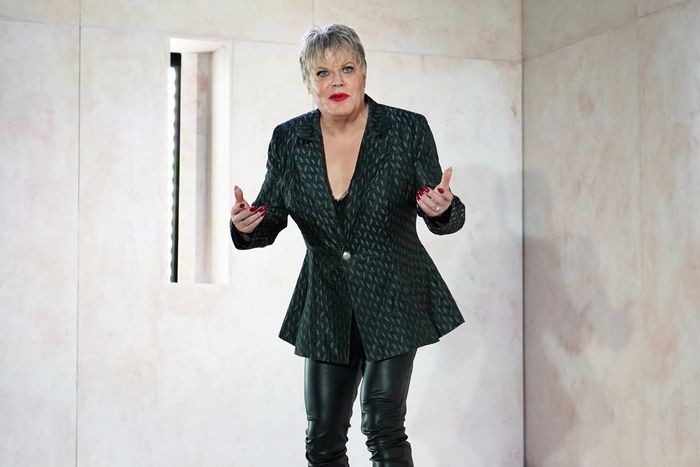
Along with being one of the most beloved, awarded, and enthusiastically quoted stand-up comedians in the game for the past thirty-plus years, Eddie Izzard is a marathoner. In 2016, she ran 27 marathons in 27 days, crossing South Africa in tribute to Nelson Mandela, who spent 27 years in prison. In 2020, she ran 29 marathons in 29 days to raise money for charity. (It was supposed to be 28, but the day after she finished she thought, Oh, what the hell and ran another one.) In January 2021, she did the 26.2 miles on her treadmill every day of the month, and performed a stand-up gig every night. I don’t know how any of this is physically possible, but I’ve heard from people who, like Eddie and unlike me, apparently enjoy cardio (I have my doubts) that the key is to “pace yourself.”
As advice to a runner, that seems solid enough. But Izzard’s current theatrical project—23 roles in a solo Hamlet, adapted by her brother Mark Izzard and directed without interpretive flourish by Selina Cadell—offers a proof for why the melancholy Dane didn’t include similar guidance in his advice to the players. In the marbled white box of Tom Piper’s set, Izzard approaches Shakespeare’s play like a diligent athlete: She focuses, metes out her energy, and avoids burnout. She also avoids tragedy and revelation. It’s clear that she’s working hard to complete a challenging task, but what’s at stake for her, and for all of us, beyond the simple goal of completion is unclear. What is the play about for her, and for Cadell? Why tell us this story? At this point in its history, Hamlet has an unhelpful Everest of precedent, expectation, opinion, and awe built up around it. That eminence seems to have attracted Izzard’s ambition, but the distance runner in her has eclipsed the actor. Taking on Hamlet doesn’t just mean getting it done. It’s not a matter of reaching the top (or planting a flag); it’s a matter of burrowing inwards — clearing a tunnel through the hardened strata of reputation to mine for the story’s heart.
Despite her years of charismatic ease on stage—and despite the relative brevity of her brother’s adaptation, which has trimmed Shakespeare’s longest text to just under two and a half hours including intermission—Izzard starts out stiffly. Perhaps the fact that Hamlet begins with several characters on edge in the dark isn’t serving her, but narrative content aside, there’s still a whiff of actorly tension in the air, almost as if Izzard feels she needs to prove that she can keep a straight and solemn face. At the same time, as she takes on Hamlet’s pal Horatio and the guard Bernardo, her physicality undermines that solemnity. To embody multiple characters, Izzard does what she’s always done in stand-up, and what it’s anyone’s first impulse to do when telling a manic, funny story in multiple personas: She hops back and forth to face herself—or rather, to face the empty space where she just was—as she switches parts. The show credits a movement director (Didi Hopkins), but even so, there’s something a shade too automatic, too clumsily literal in Izzard’s gestural vocabulary. If the entire enterprise were pitched in a different tone—more frenetic, more openly comic, wily, or satirical—this might not matter. But more often than not, Izzard seems earnestly committed to doing Hamlet straight down the middle.
That’s a double shame, for not only is it a waste of her weapons-grade comic chops; it’s also an underestimation of the play. Hamlet, no matter how many people end up dead at the end, is funny. To their credit, Izzard and Cadell eventually start to allow for this, though the mood is always more wry than raucous. Somewhere around Hamlet’s sick burn “Thrift, thrift, Horatio! The funeral baked meats / Did coldly furnish forth the marriage tables,” the old wit flashes in Izzard’s eyes. People laugh, as they should, and she can’t resist it, and she shouldn’t. Once she warms up, her particular blend of panache and silliness begins to shine through. Hamlet’s toadying friends, the hangers-on Rosencrantz and Guildenstern, are Izzard’s own talking hands, popping up to face her like a pair of Muppets. Their entrances always take her slightly by surprise, and their exits always involve a muttered chorus of “My lord,” “My lord,” before Izzard rolls her eyes and lets her little hand puppets flutter away.
It’s a fun running gag (incidentally, should she be looking for one, “Running Gag” wouldn’t be a bad name for her next marathon-and-stand-up fundraiser), and the levity it encourages allows us to enter into a real relationship with Izzard — a crucial element that’s often bizarrely lacking here. Stand-up is fueled by the same energizing feedback loop between performer and audience that can and should also fuel Shakespeare. Cadell even highlights this catalytic exchange in her director’s note: “Eddie Izzard,” she writes, “has a way of talking to an audience … that is reminiscent of her early years of street performance. Shakespeare’s theatre was essentially street theatre. No darkness separated the audience from the cast … This fabulous, fundamental connection to the audience kept the experience present. When Eddie and I first discussed doing a Shakespeare play together, this was what I thought would be the key ingredient. Talking to the house. Acknowledging the audience as the purpose of the evening, making theatre together.”
They could have fooled me. Though Izzard is far from a tedious host—she is, as she always has been, a uniquely enjoyable human being to spend time with—Cadell hasn’t followed through on her premise. Tyler Elich’s lights keep the audience conventionally in the dark, and Eliza Thompson’s original music—a dismal blend of low strings and horns that comes off as royalty-free “medieval”—gives us the feeling of listening to a live book-on-tape rather than engaging in a full theatrical event. Most discouraging of all, Izzard doesn’t connect with us all that much. Of course she looks out through the footlights during the soliloquies, but her Hamlet doesn’t really need us. She could get to the end of “To be or not to be” without seeking the answer in our eyes. Our presence—and thus the whole project we’re embarked upon together—lacks urgency. Izzard isn’t soaring to the text’s dizzying heights or dropping to its gutting psychophysical depths: She’s making her way steadily through.
This compression of the play’s peaks and chasms into a flatter, more manageable package is also a matter of adaptation. Mark Izzard’s cut is heavy on paraphrase. Less familiar words are regularly replaced with modern synonyms, and though the intention is honorable (Izzard has spoken of wanting the show to be accessible to “the people who don’t find Shakespeare easy, like I didn’t when I was a dyslexic kid”), the substitutions clank and clunk. “For who would bear the whips and scorns of time … / When he himself might his quietus make / With a bare bodkin?” becomes “When he himself might his departure make / With a mere dagger”; “the rank sweat of an enseamed bed” becomes “grease-covered bed.” It’s not as if the Izzards are alone here — people have been throwing resources into “translating” Shakespeare for centuries. But what these ventures always miss is this: Poetry isn’t just about immediate, literal understanding, and it is the job of the actor and the director, as much as it is the job of the text itself, to stimulate both comprehension and revelation. Poetry uses many tools to convey meaning: We may never have heard the word “enseamed,” but when we hear an actor—wild with distress, disgusted to the point of nausea—stretch and hiss its syllables as if retching poison, then we learn something by feeling it. Whether or not you change the vocabulary, this fully embodied investment in the text—this savoring and sharing of its every nuance—is still the job. When we update the text and then fail to do the job, all we do is throw fuel on the facile notion that perhaps these plays are too elitist and crusty for us after all.
But let that go. Though Izzard may not be seizing Hamlet by its viscera, she speaks the text with fluency and good grace. In her sharp red nails, skinny trousers, and black damask jacket with its softly Elizabethan peplum, she cuts an archly regal figure. She’s clearly here to take on a giant of literature and—like Hamlet and Laertes as they choose their foils—meet it in honorable battle. I only wish she had allowed herself less reverence and more freedom. Hamlet has supped full with honors. What it needs now is playfulness and purpose. It needs directors and performers willing, in a dark room packed thick with ghosts, to light a torch and ask—really ask—“Who’s there?”
Hamlet is at the Greenwich House Theater through March 16.


